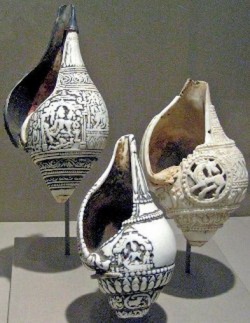Difference between revisions of "Conch"
(Created page with "thumb|250px| Saṅkha is the marine mollusk ''Turbinella pyrum'' which is found in the waters of southern and western India. A hole was sometimes made in t...") |
|||
| Line 1: | Line 1: | ||
[[File:Sankha.jpg|thumb|250px|]] | [[File:Sankha.jpg|thumb|250px|]] | ||
| − | Saṅkha is the marine mollusk ''Turbinella pyrum'' which is found in the waters of southern and western India. A hole was sometimes made in the end of the shell of this creature so that it could be blown as a kind of trumpet. The Jātaka says that the conch was sometimes blown to the accompaniment of a drum (Ja.IV,21). The Buddha mentioned that the deep resonant sound of the conch could be heard over a long distance (D.I,251). But it was something else about the conch which made it so special to the ancient Indians. The thick, dense shell can be polished to an unusually pure, shiny white. This made it a symbol of purity, goodness and perfection The Buddha described the life of the virtuous, disciplined monk a being `perfectly clean, perfectly pure and polished like a conch shell.' (A.V,204; D.I,63). Conch shells were considered one of the ten precious things found in the ocean along with pearl crystal beryl quartz red coral silver gold, ruby and emerald (Ud.54). To have three wrinkles on the neck like the lines of the spiral on a conch was considered a sign of beauty (Ja.V,155; IV,130) and shells spiraling to the right, which are extremely rare, were considered particularly auspicious (Ja.IV,350). | + | [[Saṅkha]] is the marine mollusk ''Turbinella pyrum'' which is found in the waters of southern and western [[India]]. A hole was sometimes made in the end of the shell of this creature so that it could be blown as a kind of {{Wiki|trumpet}}. The [[Jātaka]] says that the [[conch]] was sometimes blown to the accompaniment of a drum (Ja.IV,21). The [[Buddha]] mentioned that the deep resonant sound of the [[conch]] could be heard over a long distance (D.I,251). But it was something else about the [[conch]] which made it so special to the ancient Indians. The thick, dense shell can be polished to an unusually pure, shiny white. This made it a [[symbol]] of [[purity]], [[goodness]] and [[perfection]] The [[Buddha]] described the life of the virtuous, disciplined [[monk]] a being `perfectly clean, perfectly pure and polished like a [[conch shell]].' (A.V,204; D.I,63). [[Conch shells]] were considered one of the ten precious things found in the ocean along with {{Wiki|pearl}} {{Wiki|crystal}} {{Wiki|beryl}} {{Wiki|quartz}} {{Wiki|red coral}} {{Wiki|silver}} {{Wiki|gold}}, {{Wiki|ruby}} and {{Wiki|emerald}} (Ud.54). To have three wrinkles on the neck like the lines of the spiral on a [[conch]] was considered a sign of beauty (Ja.V,155; IV,130) and shells spiraling to the right, which are extremely rare, were considered particularly {{Wiki|auspicious}} (Ja.IV,350). |
| − | In time, the conch came to be considered, not just beautiful, but also sacred. During coronation ceremonies water from three conch shells was sprinkled on the monarch's head (Ja.II,409; IV,493) and they were and still are widely used in Hindu, Buddhist, Hindu and Sikh religious ceremonies. A conch is often blown to mark the commencement important events. | + | In time, the [[conch]] came to be considered, not just beautiful, but also sacred. During coronation ceremonies water from three [[conch shells]] was sprinkled on the {{Wiki|monarch}}'s head (Ja.II,409; IV,493) and they were and still are widely used in {{Wiki|Hindu}}, [[Buddhist]], Hindu and {{Wiki|Sikh}} [[religious]] {{Wiki|ceremonies}}. A [[conch]] is often blown to mark the commencement important events. |
{{R}} | {{R}} | ||
[http://www.buddhisma2z.com/content.php?id=502 www.buddhisma2z.com] | [http://www.buddhisma2z.com/content.php?id=502 www.buddhisma2z.com] | ||
Revision as of 12:31, 29 July 2013
Saṅkha is the marine mollusk Turbinella pyrum which is found in the waters of southern and western India. A hole was sometimes made in the end of the shell of this creature so that it could be blown as a kind of trumpet. The Jātaka says that the conch was sometimes blown to the accompaniment of a drum (Ja.IV,21). The Buddha mentioned that the deep resonant sound of the conch could be heard over a long distance (D.I,251). But it was something else about the conch which made it so special to the ancient Indians. The thick, dense shell can be polished to an unusually pure, shiny white. This made it a symbol of purity, goodness and perfection The Buddha described the life of the virtuous, disciplined monk a being `perfectly clean, perfectly pure and polished like a conch shell.' (A.V,204; D.I,63). Conch shells were considered one of the ten precious things found in the ocean along with pearl crystal beryl quartz red coral silver gold, ruby and emerald (Ud.54). To have three wrinkles on the neck like the lines of the spiral on a conch was considered a sign of beauty (Ja.V,155; IV,130) and shells spiraling to the right, which are extremely rare, were considered particularly auspicious (Ja.IV,350). In time, the conch came to be considered, not just beautiful, but also sacred. During coronation ceremonies water from three conch shells was sprinkled on the monarch's head (Ja.II,409; IV,493) and they were and still are widely used in Hindu, Buddhist, Hindu and Sikh religious ceremonies. A conch is often blown to mark the commencement important events.
